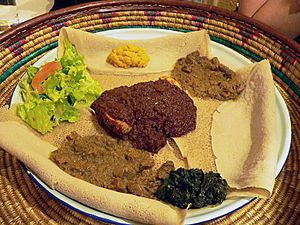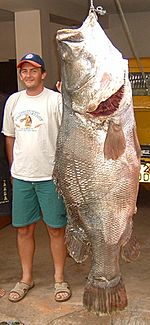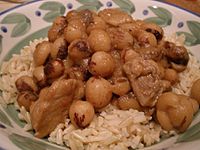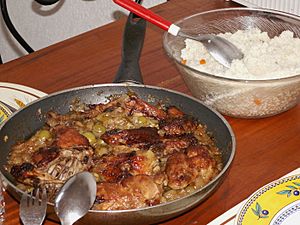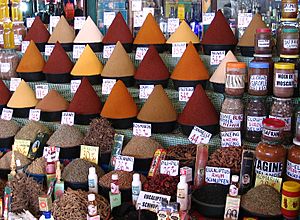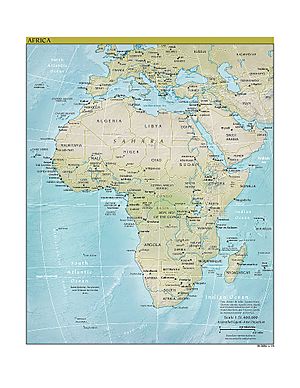List of African cuisines facts for kids
Africa is a huge continent with many different cultures and traditions. This means there are lots of unique and tasty ways of cooking! An African cuisine is a special style of cooking that uses local fruits, grains, vegetables, milk, and meat. People across Africa have many different eating habits, dishes, and ways to prepare food.
Contents
Central African Flavors
Central Africa stretches from the Tibesti Mountains to the Congo River basin. This area has been influenced by different cultures, making its food very interesting.
Swahili and Portuguese Touches
The Swahili people, who have roots in Bantu, Yemeni, Omani, and Indian cultures, brought their cooking styles to Central Africa. You can see this in dishes like mandazi (a type of doughnut), pilaf rice, kachumbari (a fresh salad), sambsusa (like samosas), and kuku paka (chicken in coconut curry).
The Portuguese also influenced Central African food, especially in countries like Angola. They introduced salted fish, which is still popular today. The word for salted fish, makayabu, even comes from the Portuguese word bacalhau!
Main Ingredients and Dishes
The main foods in Central Africa are plantains, cassava, rice, and yams. Fufu, a starchy dough, is often made from fermented cassava roots. It's usually served with grilled meat, fish, stews, and greens. Many dishes use spinach cooked with tomatoes, peppers, onions, and peanut butter. Potatoes are also a main ingredient in eastern Central Africa, as they grow well there.
People also eat cassava leaves as cooked greens. Peanut stew, made with chicken, okra, ginger, and other spices, is another favorite. While beef and chicken are common, some areas also serve game meats like crocodile or antelope. Bambara is a sweet porridge made from rice, peanut butter, and sugar. A special way of cooking is jomba, where food is wrapped in fresh plantain leaves and cooked over hot coals.
- Cameroonian Cuisine: Cameroon's food is very diverse because it's located where North, West, and Central Africa meet. French cooking also has a big influence due to its history.
- Congolese Cuisine: The Democratic Republic of the Congo has a wide variety of foods, influenced by East, Southern, Portuguese, Middle Eastern, and Indian cooking. Moambé chicken is their national dish.
- Central African Republic Cuisine: This country's food also shows influences from the Middle East and France.
East African Delights
East Africa is a huge region with many different cuisines.
- Burundian Cuisine: Burundi is a country with mountains and farms. Their main crops are coffee, tea, corn, beans, and cassava.
- Eritrean Cuisine: Eritrean food is a mix of its own traditions and influences from other cultures due to a long history of trade.
- Ethiopian and Eritrean Cuisine: These cuisines are known for spicy vegetable and meat dishes called wat (stew). They are usually served on injera, a large, spongy flatbread made from fermented teff flour. Ethiopians eat with their right hands, using pieces of injera to scoop up the food.
- Kenyan Cuisine: There isn't one single dish that represents all of Kenya. Different communities have their own traditional foods. Common foods include ugali (a thick porridge), sukuma wiki (collard greens), and nyama choma (grilled meat).
- Somali Cuisine: Somali food is a mix of native traditions with influences from Yemeni, Persian, Indian, and Italian cooking.
- Tanzanian Cuisine: Along the coast, spicy foods and coconut milk are common. Inland regions also have their own unique dishes.
- Ugandan Cuisine: Ugandan food mixes traditional and modern styles, with influences from English, Arab, and Indian cooking. Meals can range from simple starchy foods with a sauce to fancy multi-course meals.
- Maasai Cuisine: The Maasai people traditionally eat cow's milk and cornmeal. They also make soups from plants and fruits. Recently, they've started eating more foods like rice, potatoes, and cabbage.
North African Tastes
North African cuisine, also called Maghrebi cuisine, comes from countries along the Mediterranean Sea, like Algeria, Egypt, Libya, Morocco, and Tunisia.
Common Foods and Dishes
In North African cooking, common foods include meat (like lamb, beef, and goat), seafood, dates, almonds, olives, and various fruits and vegetables. Since most people in the region are Muslim, they usually eat halal meats, which are prepared in a special way. The most famous North African dishes are couscous (tiny pasta grains) and tajine (a slow-cooked stew).
- Algerian Cuisine: Algerian food is a special mix of Berber, Arab, Ottoman, and French cooking styles.
- Egyptian Cuisine: Egyptian food uses a lot of legumes (like lentils and beans) and vegetables, thanks to the fertile Nile Valley.
- Libyan Cuisine: Libyan food is influenced by Mediterranean and North African traditions, with some Italian touches from its colonial past.
- Moroccan Cuisine: Moroccan food is very diverse because of Morocco's long history of interacting with other cultures. It has Berber, Moorish, Mediterranean, and Middle Eastern influences. The cooks in the royal kitchens helped create the famous Moroccan cuisine we know today.
- Sudanese Cuisine: Sudanese food changes by region and has been influenced by Arab traders who brought spices like red pepper and garlic.
- Tunisian Cuisine: Tunisian food is a mix of Mediterranean and desert cooking traditions. Its famous spicy flavor comes from neighboring countries and the many civilizations that have ruled Tunisia, like the Phoenicians, Romans, Arabs, and French.
Southern African Flavors
South African cuisine is sometimes called "rainbow cuisine" because it's a blend of many different cultures. Curried dishes are very popular, brought by Indian laborers in the 1800s. South African food includes cooking styles from indigenous people like the Khoisan and Zulu, as well as settlers from Indian, Dutch, and British backgrounds.
- Botswana Cuisine: Botswana's food is unique but also shares similarities with other Southern African cuisines. Examples include pap (a cornmeal porridge), samp (dried corn kernels), and vetkoek (fried dough). A special dish is seswaa, which is heavily salted mashed meat.
- Malagasy Cuisine: This is the food of Madagascar, an island country. Rice is a common main food, and fruits and vegetables are very important. Pineapples, mangoes, peaches, grapes, avocados, and lychees grow on the island. Meats include chicken, beef, and fish. Curry dishes are common. A popular food is laoka, which is cooked food served with rice, often in a sauce.
- Mauritian Cuisine: The food of Mauritius is mostly influenced by the many different people who have moved to the island.
- Namibian Cuisine: Namibian food is influenced by the cooking of its native people and by German, Dutch, and British settlers.
- South African Cuisine: As mentioned, it's called "rainbow cuisine" due to its many cultural sources. A main food is pap, made from cornmeal, often served with braai (barbecued) meat at social gatherings.
- Zimbabwean Cuisine: Like many African countries, Zimbabweans rely on a few main foods. Mealie meal (cornmeal) is used to make sadza (a thick porridge) or bota (a thinner porridge). Zimbabwean food also includes fruits and vegetables like African kale. Corn is also used to make dishes like umxhanxa, which is boiled pumpkin and corn.
West African Dishes
West African cuisine includes many different regional and ethnic cooking styles. The climate varies from desert to tropical. Some local plants, like Hausa groundnuts and cowpeas, provide protein. Many important spices and herbs come from West Africa's forests. Ancient Africans even domesticated the kola nut and coffee, which are now used worldwide!
- Burkinabe Cuisine: The food of Burkina Faso is similar to other West African cuisines. It's based on staple foods like sorghum, millet, rice, corn, peanuts, potatoes, beans, yams, and okra. Grilled meat, especially mutton, goat, beef, and fish, is common.
- Ghanaian Cuisine: Ghana has many traditional dishes. Foods also change depending on the season, time of day, and special occasions.
- Ivorian Cuisine: The traditional food of Côte d'Ivoire (Ivory Coast) uses tubers (like yams), grains, chicken, seafood, fish, fresh fruits, vegetables, and spices. It's very similar to its neighboring countries. Côte d'Ivoire is one of the world's largest cocoa producers.
- Nigerian Cuisine: Like other West African cuisines, Nigerian food uses spices and herbs with palm oil or peanut oil to create rich, flavorful sauces and soups, often made very hot with chili peppers. Nigerian feasts are colorful and grand, and you can find many aromatic snacks cooked on barbecues or fried in oil.
- Sierra Leonean Cuisine: Sierra Leonean food includes cassava bread, fried fish, and okra soup.
- Senegalese Cuisine: Senegalese food has been influenced by France, Portugal, North Africa, and many ethnic groups, especially the Wolof people. Islam and European cultures (especially French) also played a role.
Images for kids
See also




